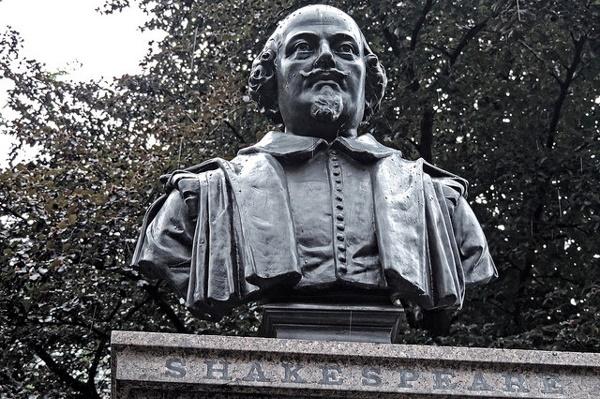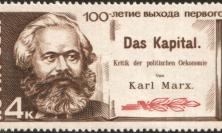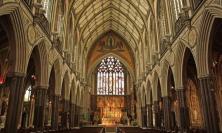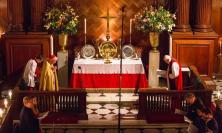Early London audiences, whose ‘appetite for sermons was insatiable’, would have heard in the words of Shakespeare’s plays plenty of allusions to and echoes of biblical ideas, writes Gerard Kilroy. As we celebrate the 400th anniversary of Shakespeare’s death, take a brief tour of the world of learning to which his plays continue to introduce people all over the world.
William Shakespeare, the fourth centenary of whose death we are celebrating, now belongs to the whole world. The Globe theatre company recently reminded us of this when it performed Hamlet in the Zaatari refugee camp in Jordan, near the Syrian border, and then in the ‘Jungle’ (in Calais) to Syrian, Afghan and Eritrean refugees. From Gdansk, where they will be holding street parties, to Serbia, Barcelona and Armenia, there are festivals celebrating Shakespeare and players performing, in every language under the sun, from a collection of more than 37 comedies, tragedies and histories.
The streets of London
The celebrations may be global, but their roots can be traced back to London, a city whose importance to Shakespeare has been the focus of many recent studies, such as Hannah Crawforth’s Shakespeare in London (2015). James Shapiro, whose two books on 1599 and 1606 have set a new trend in Shakespeare biography, estimates that in any given week, 20,000 Londoners – one tenth of the population – paid to see a play. In each of the open-roofed amphitheatres, such as the Globe, scholars estimate there were no less than a thousand ‘garlic-breathed stinkards’, packed so tightly that each was ‘pasted to the barmy jacket of a Beer-brewer’. Later, there were two indoor theatres, which attracted a more educated and courtly audience. After 1609, Shakespeare seems to have written Pericles, The Winter’s Tale, Cymbeline and The Tempest (sometimes called the ‘late romances’) for this interior, candle-lit space, where each scene had to be shorter than a candle’s length.
From the extensive use of allusion in their work, it is clear that playwrights of the time relied on this dedicated audience of playgoers who could pick up the slightest echo, and one of the most exciting developments in recent scholarship has been the attention paid to the oral culture of early modern London. Arnold Hunt, in The Art of Hearing (2010), reveals a city where the appetite for sermons was insatiable, where audiences of 6,000 stood for two hours at Paul’s Cross, an open-air pulpit, and preachers tried to prevent their parishioners from ‘sermon-gadding’: rushing from one long sermon to another on a Sunday. Audiences accustomed to complex hermeneutical homilies, to hearing the Bible in school, from the pulpit and in disputations, would have had no difficulty in recognising the allusions in the plays, as Hannibal Hamlin, in The Bible in Shakespeare (2013) has convincingly shown. An experienced reader or playgoer, attuned to such allusive practice, could find plenty to please his ear and eye.
The Word in the words
In Romeo and Juliet, for example, Shakespeare surrounds the ‘garden plot’ of his source (Arthur Brooke’s poem The Tragical History of Romeus and Juliet) with ‘orchard walls’, turning the garden into a ‘paradise’, the word ultimately derived from the Old Persian for a walled enclosure: paridayda. The most influential use of such a hortus conclusus was in the Song of Solomon (4:12), where it was interpreted allegorically as the Blessed Virgin, the antitype of Eva (a theological truth reinforced by the Latin anagram of Ave and Eva). Romeo’s first description of Juliet also uses biblical images associated with the Virgin Mary, a ‘woman clothed with the sun, with the moon under her feet, and on her head a crown of twelve stars’ (Revelation 12:1).
In King Lear, Cordelia, announces:
O dear father,It is thy business that I go about.
The phrase was first included in the Bible by William Tyndale (when Jesus asks his mother, ‘Did you not know I must be about my father’s business?’) in 1526, and then by Miles Coverdale in 1535, followed by Gregory Martin in the Rheims translation in 1582, so the Christological echo is very precise.
The phrase, ‘All hail, Master!’ was first heard in the York Mystery Plays, where it accompanies Judas’s kiss in Gethsemane. Hamlin has found it in several sermons between 1571 and 1599, and in several of Shakespeare’s plays, sometimes with the Judas reference explicit, as in Richard II; in Julius Caesar and Macbeth, the audience must have caught the allusion immediately: it was a sure sign that treachery and murder were to follow. Preachers and playwrights were working in parallel.
One of the most popular of the mystery plays was The Harrowing of Hell, where Christ descends into hell to rescue all the souls waiting there. It was a very dramatic episode, frequently represented in art, involving a confrontation between Satan and Christ. Emrys Jones, in Scenic Form in Shakespeare (1971), argued that the stage direction ‘Knock’ in the Folio Macbeth, repeated no fewer than ten times, is an economical way of reminding the audience of the knocking of Christ at the gate of hell, and of telling them that Macbeth has turned his castle into hell. When The Harrowing of Hell was performed in churches, Christ came in through the south door; Macduff, the one knocking ‘at the south entry’, is the Christ-figure in the play, the victorious antagonist.
In Hamlet, once the Ghost unfurls the full story of ‘decline’ and ‘falling-off’ in Denmark, the story becomes laden with typological metaphors from the Bible that cry out for interpretation:
Tis given out that, sleeping in my orchard,A serpent stung me. So the whole ear [air] of DenmarkIs by a forged process of my deathRankly abused; but know, thou noble youth,The serpent that did sting thy father’s lifeNow wears his crown. (I.5)The serpent in the garden, the falling-off, the poison, the corruption spreading through the body politic (reinforced by the synecdoche Denmark), all draw us into the fallen world of Man.
The Merchant of Venice, far from being a play about anti-Semitism, celebrates the way the new covenant of mercy has taken over from the old covenant of the law. After the drama of the court scene where mercy is shown to work more effectively than justice, the ending echoes – as Clare Asquith, in Shadowplay (2005), suggests – the refrain of the Easter hymn, the Exsultet: ‘haec nox est ... haec nox est ... haec nox est ... o vere beata nox’, which celebrates a continuum of paschal escapes, through the Red Sea and out of the tomb, in Jewish and Christian history. In a lyrical duet, the phrase ‘In such a night’ is repeated eight times by Lorenzo and Jessica: less an epilogue to the humiliation of Shylock, more a symbolic marriage of the law and love.
The man behind the words
But what of the man? It is only a slight exaggeration to say that the date of his death is almost all we know about William Shakespeare. A baptismal certificate suggests he may have been born on the same day, 23 April; there is a marriage certificate and a will with a famously ambiguous clause about the second-best bed; a tomb; several disputed portraits; three signatures; no letters preserved by friends and family; and, remarkably, no manuscripts of the plays. It is possible that the two hundred lines in a manuscript of the play, Sir Thomas More, a play with several authors, are by Shakespeare. Many have attempted the Herculean task of constructing a biography; the best, such as Stephen Greenblatt’s Will in the World (2004) and Rene Weis’s Shakespeare Revealed (2008), use the plays.
The attempts to argue that the plays were really written by someone else are flawed on so many counts. Not one of Shakespeare’s contemporaries ever hints that ‘Shakespeare’ is really a pseudonym, and the idea that Edward de Vere, 17th Earl of Oxford, a spectacularly argumentative and predatory character, wrote these exquisite masterpieces, barely stands scrutiny. ‘The play’s the thing’: a mystery even more profound than his life.
A world of learning
Shakespeare’s plays continue to inspire other works of art. Jane Austen clearly loved Much Ado about Not(h)ing (as it was then pronounced, the pun showing how little we can rely on the evidence of our eyes) so much that she used its structure and theme as the basis for two of her best novels. Pride and Prejudice echoes the epistemological theme of its model, and Emma transforms the central image of the window into a profound study of the relations between our mind and our sight. Hector Berlioz, who reeled out of a performance of Hamlet in 1827, became obsessed by Shakespeare (and Harriet Smithson who was playing Ophelia and Juliet), and adapted Much Ado about Nothing for his Béatrice et Bénédict (1862). Among the two hundred operas inspired by Shakespeare are Verdi’s Macbeth and Otello. Prokofiev’s ballet Romeo and Juliet was composed and revised during the late 1930s; there are some twenty other operas of this tragedy; and a musical adaptation in West Side Story, first performed in 1957, with music by Leonard Bernstein and lyrics by Stephen Sondheim.
Shakespeare has been equally popular in cinema. There are over fifty films of Hamlet: the 1964 adaptation by the great Russian director, Grigori Kozintsev, is now a cinematic classic, with translation by Boris Pasternak and music by Dmitri Shostakovich. In Japan, where they study more Shakespeare than any Japanese playwright, the director Akira Kurosawa adapted Macbeth as Throne of Blood (1957), Hamlet as The Bad Sleep Well (1960) and King Lear as Ran (1985). It is hard to think of any other writer, composer or artist who has continued to be a source of such varied and creative inspiration in so many different cultures and such diverse genres: sometimes with very precise political impact. For his second production of Hamlet in Prague, in 1982, the great Czech stage designer, Josef Svoboda, constructed a series of stepped platforms enveloped in black velvet drapes. In front of them, and coming down over most of the stage was a huge fire-curtain. Professor Sdeněk Stříbrný, who described this in Shakespeare in Eastern Europe (2000), explained that the word in Czech for a fire-curtain is Iron Curtain, so that when it was lifted up at the end, light flooded the stage: ‘Claudius, groping desperately for help before Hamlet’s ferocious attack, tore down the black drapery and died among the tatters, pinned down for what he was, “a king of shreds and patches”’. The audience knew exactly what was meant. Hamlet is not kind to political power, and certainly not to kings (or presidents) who use poison, whether in a chalice or a cup of tea, to dispose of their enemies.
In an age where virtual images on multiple screens threaten learning, culture and real human dialogue, the survival of Shakespeare represents a beacon in the darkness. Like some medieval cathedral library, his works remind us how extensive was the reading of every educated man in Europe. Beneath the beautiful lines of Shakespeare, as Brian Cummings in Mortal Thoughts (2014) has shown, lie traces of a vanished world of learning: Dante, Augustine, Seneca, Cicero, Plutarch, Virgil and Ovid. Shakespeare was part of a vigorous dialogue with a world of books. Niccoló Machiavelli (d. 1527) tells us that he put on his court dress before entering his library, where, for the space of four hours in ‘the ancient courts of ancient men’ he ‘was not ashamed to speak with them and to ask them the reason for their actions’. On 23 April 2016, we too should imitate Machiavelli, put on formal clothes, and read Shakespeare’s sonnets, poems and plays in the same spirit of dialogue, curiosity and reverence. We may be able to imagine ourselves, like Virginia Woolf’s Orlando, watching Othello for the first time, or responding to the philosophical and theological challenge in the opening line of Hamlet: ‘Who’s there?’ in the darkness, among the dead, in ‘the undiscovered country’.
Gerard Kilroy is Honorary Visiting Professor at University College London. His most recent book is Edmund Campion: A Scholarly Life (Ashgate, 2015), a full biography of the Jesuit priest and martyr. He is currently a Visiting Professor at the Ignatianum in Krakow, where he is giving a course of lectures on five plays of Shakespeare.






